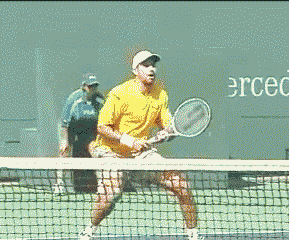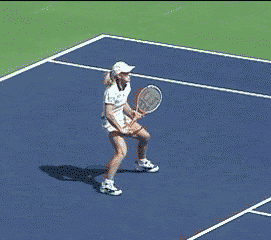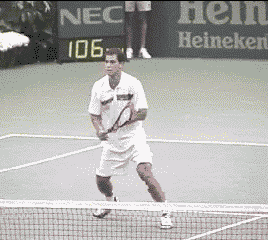|
TennisOne Lessons Controlling the High Volley An Often Misunderstood Shot Dave Smith TennisOne Senior Editor
How many times have you seen a player, standing literally right on top of the net, end up burying a high volley into the bottom of the net? It seems nearly impossible to hit a ball so straight down it doesn’t even come close to clearing the net! Or better yet, how many times have you seen this same high volley whacked into the back fence on the fly? And let's not forget, these players are positioned right on top of the net. Such high volleys offer a sense of the ‘can’t miss’ attitude in the mind of many players. Yet, at intermediate levels of play—and even higher—we see these seemingly innocuous balls hit into seemingly impossible places. High volleys at mid court are equally misplayed. There is a sense of “I should kill this floater” in the mind of the player, yet because they have missed this shot so many times, they either end up dinking the ball over or go after it with abandon, resulting in balls hit not only into the net or back fence, but I’ve seen such shots hit over the fence! The fact is most players do better with volleys at waist height or lower rather than these shoulder-to-head-high volleys. So, what is it about these balls that are not quite high enough for an overhead but just out of the comfort zone for a normal volley? There are a few issues related to biomechanics and physics that we can study to understand why so many players fail at these seemingly very easy shots.Reverse Pendulum Like that of a swinging pendulum where the ‘bob’ or the end of the pendulum swings in an arc around a fixed point, a racquet face that swings high around the shoulder point will also move in an arc unless guided by the player to change this curved swing path. I call the action of this swinging racquet over the head a ‘reverse pendulum.’ That is, instead of swinging back and forth while hanging down like a grandfather clock’s pendulum, a reverse pendulum swings above the fixed point. When a racquet is swung over the head with a relatively straight arm (unlike the action of an overhead where the elbow flexes and the racquet collapses behind the head prior to extension and contact), the racquet face moves from open to closed within the arc. Thus, if the player does nothing to correct this swing characteristic, the timing of the shot becomes paramount. If hit late, the racquet face will be open at contact and the ball will go well long. If struck early, the racquet face will be closed at contact and the ball will head downward.
If we learn to ‘keep the plane the same’ and swing the racquet forward on a more horizontal plane with the racquet face maintaining its integrity, you will increase the likelihood of hitting the ball with a proper racquet orientation at contact. You can hit a bit late or a bit early and the racquet face will still be in a relative position to keep the ball within the context of your aim. Angle of Reflection Many players are instructed to hit their volleys flat, regardless of whether the volley is hit at head height or down by the knees. While some players can indeed drive many flat volleys successfully, the required racquet control for such shots to be hit consistently is difficult. If a player is attempting to hit the ball flat, and the angle of the racquet is off by even a slight amount, the ball will usually be hit either in the net or long. Because flat volleys don’t take pace off the ball, players usually end up becoming ‘gravity reliant,' a precursor to becoming the dreaded tennis ‘dinker’! (See my article ‘Are you a Tennis Dinker?’) There is a very important physics concept that contributes to so many players missing this high volley. A ball that is dropping will reflect downward off any flat surface. Most high volleys hit at mid court will have a downward trajectory. (If they are still rising at mid court, they are probably going out!) The angle in which a ball is dropping towards the flat surface will result in an equal reflective angle. While spin and gravity will have an effect on the degree of reflective angle, most players don’t realize the magnitude this concept has on a ball. At lower levels, we often see passing shots hit at a net player with underspin. A ball that has any amount of underspin will reflect considerably more downward off your flat racquet than a ball hit flat or with topspin. Responding to these high balls (and all volleys for that matter) with a slight slice (not a chop, but an open racquet face that moves forward and down slightly) will help decrease the likelihood of balls being hit into the net due to this principle. Yet, even balls that have topspin, depending on the degree of spin as well as the amount of downward arc the ball has prior to being volleyed, will reflect off a flat racquet face more than many players anticipate. Often, after hitting their flat volleys into the net, players will attempt to correct this result by hitting their flat balls more upward. Obviously, if we try to hit these volleys flat, but with an upward swing path, we can end up hitting the ball well long. I think you can see why so many developing players lose confidence in hitting high volleys and end up staying back to avoid the shot altogether! Eastern Forehand Grips with Beginners
While it is not rare to see a skilled player migrate towards an eastern forehand grip on higher volleys, these players understand other components of the swing to maximize their ability to hit such high volleys well. However, when beginners are taught the eastern grip (or choose it because it feels easier to control), they are usually taught to hit the ball well out in front of them. This action, while necessary for the eastern grip to be even remotely successful, often results in easy balls hit into the net. Try this: hold the racquet flat in front of you as if you were going to hit a typical mid to high volley. Now reach further in front of you. What does the racquet face do? That’s right! It closes, and the more you reach out in front of you, the more the racquet face closes. Now consider the anxiety of such a player in a match. These players are usually somewhat uncomfortable at the net anyway! so, when a ball comes at them, they tend to panic and jab quickly at the ball by reaching for it in front of them as they have been taught. Result: Ball into the bottom of the net. High Backhand Volleys You will often see pros bend their elbow during the unit turn when hitting a backhand volley. Yet, almost without exception, they get the arm straight prior to contact then drive this lever-like straight arm through the ball. The problem many recreational and club players have is that they see this arm bend and think, ‘oh, that's what I should do.’ However, when these club players do in fact bend their elbow, they usually do one of three things:
When a player bends the elbow on a high volley, they end up opening the racquet face as well as taking the racquet well too far back. Thus, they have to ‘swing’ the racquet to gain the proper angle of the racquet to hit the ball in the desired direction. Such a swing usually results in loss of control and lots of variability during the contact zone.
Certainly, any extra swing can result in potentially more power. However, most volley winners, even at the pro level are usually hit as winners because of placement, not necessarily power. There are exceptions to this and I am well aware of the opportunity that extra power can provide. Yet, if players sacrifice control and placement for power, they will end up on the losing side of many matches. Use the physics properties of levers: The longer the lever, the more force can be applied by that lever. Thus, if you keep your arm straight through contact, you will be able to apply more force with less effort. However, the unfamiliarity of this swing pattern usually results in players bending the elbow, flicking the wrist, or using the body to swing the racquet around. You can overcome this tendency through the conscious effort of maintaining the elbow’s firmness. Conclusion High volleys are best hit (and learned) using a continental grip, turning sideways to meet the ball, and adding a slight—not significant—slice as you drive forward through the ball. By practicing this correctly, you will gain all-important control and consistency that will later equate into hitting more confidently with additional power. Your comments are welcome. Let us know what you think about Dave Smith's article by emailing us here at TennisOne .
TENNIS MASTERYFinally. a resource that unlocks these mysteries: • Why do m • Why are making changes in one's game so frustratingly difficult? • What tennis teaching methods are disruptive or detrimental to player progression? Read David W. Smith's TENNIS MASTERY and learn not just how to avoid playing at mediocre levels, but how the best players in the world Master the sport of tennis! "With a depth of knowledge and fresh perspective, TENNIS MASTERY is set to become a manual for tennis instructors and a measure for tennis literature." Richard Wigley, Director, Kayenta Tennis Center , Ivins Utah . Take in David Smith's 30 plus years in the tennis teaching industry. This 335-page manual will provide for every level of player as well as support for all tennis-teaching professionals, a blueprint for reaching higher levels of tennis mastery. Order TENNIS MASTERY at tenniswarehouse.com , or go to tennismastery.net for exciting excerpts from the book and a host of tennis information! And check out David Smith's other articles found here at TennisONE.com Enjoy three incredible days, including: 18 hours of on-court instruction, use of the SUMMIT Athletic Club's $8 million dollar tennis, swim and fitness center, player DVD and resource notebook, signed copy of Dave Smith’s TENNIS MASTERY, and a camp that will be taught by Dave Smith himself along with his staff of top-rate USPTA certified Tennis Professionals. Each camp includes breakfast and lunch, and camp tee shirt. Custom tennis camps and dates can be also be arranged throughout the year. For more information or reservations, call (435) 628-5000 and ask for the Summit Pro Shop. |




 illions of tennis players stagnate at levels far below their potential?
illions of tennis players stagnate at levels far below their potential? 